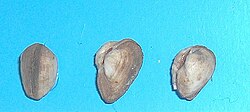| Noetiidae | |
|---|---|
 | |
| Three shells of Striarca lactea | |
| Scientific classification | |
| Domain: | Eukaryota |
| Kingdom: | Animalia |
| Phylum: | Mollusca |
| Class: | Bivalvia |
| Order: | Arcida |
| Superfamily: | Arcoidea |
| Family: | Noetiidae Stewart, 1930 |
| Genera | |
See text | |
Noetiidae is a family of saltwater clams, marine bivalve molluscs in the order Arcida. [1] [2] They are related to the ark clams and used to be classified as among them. They are differentiated from the ark clams by the presence of striations on the hinge ligament and on the placement of this ligament. Like the ark clams, however, their shells range from ovate to elongate, are inflated, and are brown and white with clear radial ribs. They usually grow to around 6 cm in length, with a maximum of 10 cm.